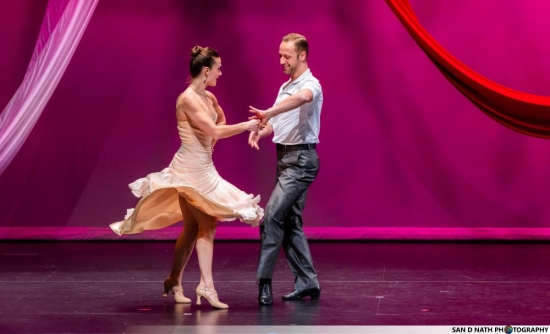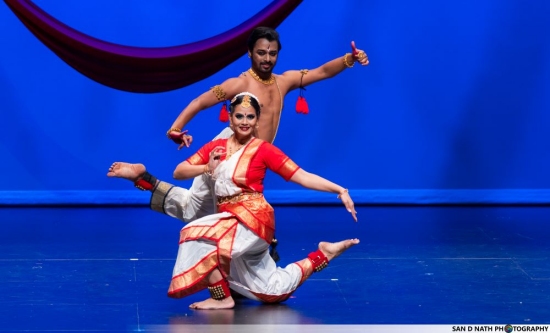
|   |

|   |
Dhrupad Jhankaar 2023 - Latha Sambamurti e-mail: lathapat.arts@gmail.com February 3, 2024 Dhrupad Jhankaar 2023, presented by Dance Tantra Academy on December 3, 2023, was for the benefit of non-profit Sadhana's various projects. This was the academy's fourth annual recital, aimed at providing a rite of passage for its students to showcase their talents. The evening began with Dhyaana Shlokam, a traditional prayer, presented by elementary school kids who have been learning Bharatanatyam for the past three years. Many young dancers gracefully portrayed neat choreography throughout the evening. The audience was invigorated with their sheer energy. Kali Tandav by a future arangetram aspirant, Sanskriti, and Hum hum kare shabarurhe, traditional lyrics re-tuned and redesigned with jatis and choreographed by Piyali Biswas were impactful.  Piyali Biswas Artistic director Piyali Biswas presented Mishra peacock alarippu on top of an inverted clay pot. Pot Bharatanatyam, also called Perani Nrityam, needs immense concentration and core strength for balancing. She balanced dancing so well on the pot maintaining elegance and balance simultaneously. An IT professional in her day job, and mom of two young girls, Piyali wears multiple hats as a Bharatanatyam performer-teacher-choreographer and artistic entrepreneur. Next was another surprise, viz., Battery Dance from New York. Battery Dance was founded in 1976 by Jonathan Hollander, a trailblazer in the field of dance. Six years later, he founded the Battery Dance Festival, now New York City's longest-running public dance festival. Two brilliant Battery Dance Company dancers from New York, Razvan Stoian and Jillian Linkowski, performing for the first time in Seattle, provided ample visual delight. Blending Stoian's ballroom dance background with a contemporary sensibility, this duet has an underlying air of tension. Set to the lush re-make of Albinoni's well-known Adagio for Strings by contemporary composer Mac Quayle, the dancers exploited theatricality and partnering to compel viewers to draw their own conclusions. Devi's Navarasa was presented by another 2024 arangetram aspirant Giya.  Battery Dance The next performance was by Subhajit Khush Das from Kolkata. He was recognized as a talented artiste in 2023 as part of Sadhana's project 'Udiyaman- the rising star,' where Sadhana and Dance Tantra Academy collaboratively award and sponsor a young adult talented artiste out of the state or internationally, arranging a platform for them to showcase to the Greater Seattle audience. Subhajit is a talented neo-classical and Bharatanatyam dancer. Running a dance troupe named Subhangik and popular on social media and YouTube channels, he's known for creativity and choreography. He presented Om Greem, a composition on Devi, the divine mother who is beautiful, compassionate, and a fierce protector. This is a compilation of ancient verses. Portraying Shiva on one side and Devi on the other side simultaneously was done skillfully and beautifully. His next presentation was an expression-based item, "Krishna nee begane," a popular padam where he depicted child Krishna and mother Yashoda. With exquisite expressions, he transported the audience to a bygone era. The highlight of his performance as Yashoda was requesting the audience not to clap as he (asYashoda) had put baby Krishna to sleep. The incredible duo from Battery Dancers performed their second piece. Inspiration for this miniature gem came from the riotous, multi-octave musical genius of the Peruvian singer Yma Sumac, who was celebrated in the Soviet Union and the United States as a recording artist, television and film star of rare virtuosity. Her glamourous style was pure kitsch, and yet her voice astounded with sonorous low notes up to her high bird-like coloratura. Bo Mambo (2021) was choreographed and performed by Jillian Linkowski and Razvan Stoian, and sung by Yma Sumac. It was a beautiful amalgamation of world art. Music from Peru with a contemporary dancer duo from New York with such brilliant choreography was an inspiring moment for Dance Tantra Academy students as well as for the audience.  Piyali Biswas and Subhajit Khush Das The highlight of the evening was Sanglaap - a dialogue between Tyagaraja & Tagore, presented by Piyali Biswas and Subhajit. Saint Tyagaraja was undoubtedly one of the most influential composers in Carnatic music in the late eighteenth century who composed many devotional compositions, mostly in Telugu, and in praise of Lord Rama. His compositions are famous even today. Here's a translation into English of his composition called Nadasudharasa. Drink the nectar of pure Nada, O Mind. Sri Rama is the incarnation of Omkara, which is the essence of the Vedas and the Shastras. The raagas have become his bow, the Kodanda. The seven notes are the bells tied to the bow and the three styles, Ghana, natya and Desya are the strings of the bow. The gatis are numerous arrows and the sangatis are his soft speech. What is the good fortune of Tyagaraja to have got this gift from the Lord. Kabiguru Rabindranath Tagore, a Nobel laureate polymath in the late 19th and early 20th centuries, reshaped Indian literature with profoundly sensitive, fresh, and beautiful compositions. He was inspired by Tyagaraja in some of his poems and sang in the same tunes as well. Tyagaraja's Lavanya Rama praises Lord Rama, but Tagore's inspiration from Tyagaraja, Eki labonye purno praan talks about the formless power of God. This marked the pinnacle of the evening. Two legendary poets / composers from Southern and Eastern India centuries ago, with Bharatanatyam and Rabindranritya by two Bengali classical dancers, touched our hearts with grace and depth. Piyali was inspired by one of her early Gurus Thankamani Kutty who has done considerable research on the works of Tagore and has presented many Bharatanatyam recitals set to Tagore's poems. This subject has more scope to expand. Piyali and Subhajit took us to a poetic world filled with music and words. All dancers were invited to the stage for the grand finale, a Gujarati bhajan, Vaishnava Jana To, written in the 15th century by the poet Narsinh Mehta. The poem speaks about the traits and the ideals of a Vaishnava Jana. This devotional hymn became popular during the lifetime of Mahatma Gandhi and was rendered as a bhajan in his Sabarmati Ashram. It was popular among freedom fighters throughout India. This poem is a traditional example of the concept of jiva-daya, a form of ahimsa that comprises experiencing the pain of others and associating it with bhakti, which is devotion to God. The event ended in a tranquil state leaving the audience in awe of the cultural experience they had with families and friends.  Latha Sambamurti is Arts and Culture Commissioner and Producer and Director of Arts & Cultural Festivals, Washington State. |